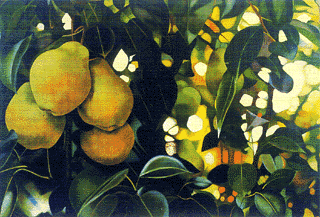Exhibitionism
Fri., May 29, 1998
Tarrytown Gallery,
through June 4

Alesi and Dove are painters who explore light and its various effects in photo-realistic works. Yet despite the harmonic qualities, these artists' paintings couldn't be more different. Where Alesi's colors are warm and inviting, Dove's are subdued and sparing. Where Alesi focuses on fruit and flora for subject matter, Dove concentrates on offices and portraits. And where the overall feel of Alesi's works are sensual and serene, Dove's works evoke a feeling of chilling loneliness. Their paintings are as different as a golden pear and a fluorescent lightbulb.
In short, that makes these artists strange bedfellows (galleryfellows?) for an exhibition. But it's also what makes this an interesting exhibition; it shows how two people can use the same media to conjure up completely different images, like Kenny G and Stan Getz — different strokes for different artist-folks.
 Alesi's strokes take us outdoors and "up close and personal" with magnified berries, fruits, and insects. The artist explores how natural light bounces off the brilliant colors of softball-sized nectarines, persimmons, pears, and pyracantha berries. The organic subject matter often appears animated, such as the cyprus vine in one of the untitled pieces. The vibrant green vine arches up like a curious chameleon, eager to venture out from its rooted home. Alesi's works are pleasant and calming, like a stroll through a healthy garden.
Alesi's strokes take us outdoors and "up close and personal" with magnified berries, fruits, and insects. The artist explores how natural light bounces off the brilliant colors of softball-sized nectarines, persimmons, pears, and pyracantha berries. The organic subject matter often appears animated, such as the cyprus vine in one of the untitled pieces. The vibrant green vine arches up like a curious chameleon, eager to venture out from its rooted home. Alesi's works are pleasant and calming, like a stroll through a healthy garden.
Then there are Dove's works, which are like a walk through the Prozac Nation. His eerie images of offices, seen through half-drawn blinds, are a glimpse at a modern-day level of Dante's Inferno. This level of Hell dooms sinners to eternity in a windowless room, with a bottomless "In" box and a glaring 5,000-watt fluorescent bulb as their only companion. This passionless setting is where many contemporary Americans spend much of their time — perhaps the point Dove hopes to brings to our attention.
Dove's portraits are slightly less disconcerting, yet still emit a feeling of lonely melancholy. Portrait of M depicts a young man, slouching in a chair with his hands crossed in his lap. His face conveys an understated bewilderment, or a subtle feeling of sadness. Dove is excellent with realistic detail, down to the folds in the man's shirt and the light bouncing off his slightly askew Caesar cut. This realism makes the works even more unsettling, bringing them still closer to home. This would be your cue to venture back to the healthy garden.
— Cari Marshall
NOW AND AGAIN: TIME IS ON MY SIDE
McCullough Theatre, UT
May 15
How do you perceive time? I'm convinced that waiting is the main thing that makes you aware of the passage of time. Whether it is everlasting anticipation, gripping suspense, or lethargic slow-motion action, it's when life slows down or grinds to a complete halt that one becomes aware of the seconds, minutes, and hours ticking by. In its evening-length workNow and Again, Johnson/Long Dance Company explores the concept of memory and mischievously plays with the audience's perception of time.
From the very beginning of the evening, the company sensitizes the audience to time's passage. As we watch, the performance unfolds: Dancers warm up, lights dim, the backdrop slowly lowers into place. We leisurely wait at a cafe in France, listening to Edith Piaf as the world strolls by our limited view. We anxiously expect the collision of two tricycle riders, one frantically pedaling in circles, the other sitting tall and unmoved in the center of the stage. We anticipate the deliberately naked emergence of two mummified dancers and watch home movies together. And we share perhaps the most familiar and excruciating waits: the wait for that damn piece of toast to pop out of the toaster. Threaded throughout the work are engaging spoken monologues featuring humorous memories and serious musings on the concept of time. The dancers seem equally at ease speaking and performing the demanding technique, proudly displaying their uniqueness within the framework of the piece.
Underneath a bowling-ball pendulum and lighted boxes with photographic evidence of both the timelessness of nature and the effects of time on the earth, one dancer anchors the action onstage with a continuous and sweeping gesture phrase that occasionally resembles the hands of a clock. Meanwhile, other dancers move in unison, lifting and counterbalancing each other. Signature phrases from this interaction reappear and recombine with new material to create a familiar interconnectedness among the performers and throughout the vignettes.
Within the piece are many enchantingly unexpected moments and interludes. After crooning a sexy ode to his man, one dancer pulls a feather duster out of his bathrobe and begins cleaning. A boxing ballerina, complete with a puffy net skirt, wins the fight of her life using real ballet steps. Following a poignant duet between a man and a woman, a jogger reappears to remove their chair and segue into the next section. It's little details like these that make the integrated piece well-paced and entertaining. The energy of the show lags in only a few places, but it quickly recovers as the scene changes.
The performance ends much as it begins, except in retrograde. Again, the audience watches as the world goes by, its view restricted to a small panel in the middle of the stage. This time, however, the music is different — softer and more lyrical. Movement that appeared humorous in the previous section now seems tender and reflective. It's a powerful choice to end the evening as a circle, echoing the cyclical nature of time. As the dancers finish the final section, the lights brighten, the backdrop slowly lifts to expose the bare walls of the stage, and the show slowly melts away.
— Dawn Davis








